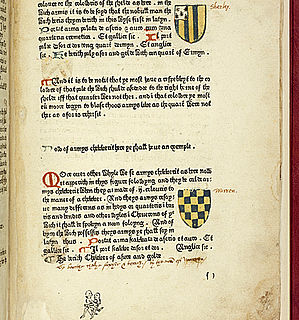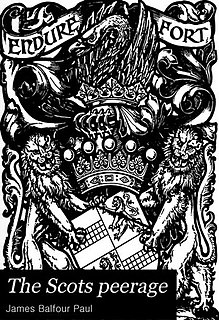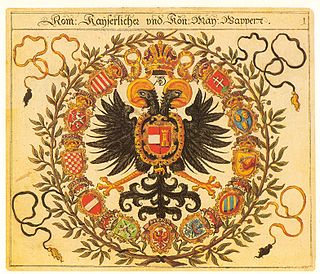 W
WThe Book of Saint Albans is the common title of a book printed in 1486 that is a compilation of matters relating to the interests of the time of a gentleman. It was the last of eight books printed by the St Albans Press in England. It is also known by titles that are more accurate, such as "The Book of Hawking, Hunting, and Blasing of Arms". The printer is sometimes called the Schoolmaster Printer. This edition credits the book, or at least the part on hunting, to Juliana Berners as there is an attribution at the end of the 1486 edition reading: "Explicit Dam Julyans Barnes in her boke of huntyng."
 W
WBurke's Landed Gentry is a reference work listing families in Great Britain and Ireland who have owned rural estates of some size. The work has been in existence from the first half of the 19th century, and was founded by John Burke. He and successors from the Burke family, and others since, have written in it on genealogy and heraldry relating to gentry families. It has evolved alongside Burke's Peerage, Baronetage & Knightage; the two works are regarded as complementing each other. Since the early 20th century the work also includes families that historically possessed landed property.
 W
WBurke's Peerage Limited is a British genealogical publisher founded in 1826, when Irish genealogist John Burke began releasing books devoted to the ancestry and heraldry of the peerage, baronetage, knightage and landed gentry of the United Kingdom. His first publication, a Genealogical and Heraldic Dictionary of the Peerage and Baronetage of the United Kingdom, was updated sporadically until 1847, when the company began releasing new editions every year as Burke's Peerage, Baronetage and Knightage.
 W
WHeraldischer Atlas; eine Sammlung von heraldischen Musterblättern für Künstler, Gewerbetreibende, sowie für Freunde der Wappenkunde was a book on heraldry by Austrian heraldist and heraldic artist Hugo Gerard Ströhl, published in Stuttgart in 1899. As the title says, it was intended as a model book for how coats of arms should be drawn.
 W
WAn ordinary of arms is a roll or register of coats of arms arranged systematically by design, with coats featuring the same principal elements grouped together. The purpose of an ordinary is to facilitate the identification of the bearer of a coat of arms from visual evidence alone.
 W
WThe Royal Belgian Genealogical and Heraldic Office is a private genealogical and heraldic society in Belgium. It was founded in 1942 as an asbl and has over a thousand members interested in genealogy and heraldry. While it publishes exclusively in French language, it covers all regions of Belgium.
 W
WThe Scots Peerage is a nine-volume book series of the Scottish nobility compiled and edited by Sir James Balfour Paul, published in Edinburgh from 1904 to 1914. The full title is The Scots Peerage: Founded on Wood's Edition of Sir Robert Douglas's Peerage of Scotland, containing an Historical and Genealogical Account of the Nobility of that Kingdom.
 W
WSiebmachers Wappenbuch is a roll of arms first published in 1605 as two heraldic multivolume book series of armorial bearings or coats of arms of the nobility of the Holy Roman Empire, as well as coats of arms of city-states and some burgher families. Founded and compiled by Johann Ambrosius Siebmacher, a German heraldic artist, copperplate engraver, etcher and publisher from Nuremberg, these works became an important source of heraldry of the German-speaking regions.
 W
WStemmatografia, known by its full name Stemmatografia sive Armorum Illiricorum delineatio, descriptio et restitutio is a heraldic essay written and illustrated by Pavao Ritter Vitezović, and originally published in 1701.